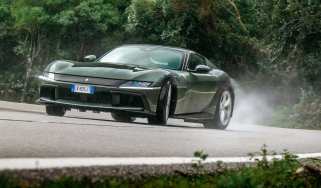Porsche 911 (992.2) – engine, gearbox and technical highlights
Engine range comprises a pair of turbocharged 3-litre flat-sixes, alongside a 3.6-litre hybrid unit and the GT3’s 4-litre naturally-aspirated motor
The 992.2 engine range is a mix of the familiar and somewhat groundbreaking. The base Carrera continues to use a 3-litre twin-turbocharged flat-six, with the latest car gaining uprated turbochargers and an intercooler from the 992.1 Turbo. This increases power from 380bhp in the 992.1 to 389bhp, with torque standing at 332lb ft. This engine also forms the basis of the lightweight, manual Carrera T.
The Carrera S receives a bigger jump over its predecessor, generating 473bhp (up from 444bhp) thanks to new turbochargers and revised charge-air cooling. Peak torque is rated at 391lb ft.
As of now, all of these models are rear-drive only, and only the Carrera T gets a six-speed manual – otherwise it’s an eight-speed dual-clutch PDK unit.
The GTS’s new hybrid powertrain is the 992.2’s biggest talking point. It’s centred around a newly-developed 3.6-litre flat-six with no belt drive for the air-conditioning system, with that being handled by a high-voltage electrical system. This makes space for a pulse inverter above the engine for the hybrid system, which uses a 54bhp electric motor integrated into the PDK gearbox. There’s another electric motor integrated into the GTS’s single turbocharger, which spins it up to build boost faster and improve response. Powering these is a 1.9kWh battery positioned at the front of the car, where the 12-volt battery is normally located. The weight penalty over a Carrera S is a modest 55kg.
More reviews
In-depth reviews
- Porsche 911 review 2025 – Gen2 992 is the 911 for the digital age
- Used Porsche 911 (991, 2011 - 2018) review – should you buy the unloved 911?
Reviews
- Kalmar 7-97 RS-R Evo 2025 review – part Porsche 911, part Ariel Nomad
- Porsche 911 Carrera GTS T-Hybrid 2025 review – the best 992 Carrera yet
- Porsche 911 S/T review – why it's our 2024 Car of the Year
- Porsche 911 Carrera (992.2) 2025 review – is the most basic 911 the sweet-spot?
- Used Porsche 911 (997, 2004-2012): review, history, specs and buying guide
The result of the hybrid assistance is both a cleaner and more powerful 911 GTS, with 534bhp and 420 lb ft of torque. That’s a gain of 61bhp, although peak torque matches the 992.1. The GTS is currently the only 992.2 offered with both two- and four-wheel drive.
The 992’s structure is more aluminium-intensive than previous generations, but retains a mixed-metal construction. Only 30 per cent of the shell is steel, and the main body pressing is aluminium. The lightest Carrera – the T – comes in at 1490kg, stretching up to 1745kg for the Targa 4 GTS.
There’s only one body shape for Carrera models, in contrast to previous versions that had varying bodies whether they were rear- or all-wheel drive. Suspension is by MacPherson struts up front (except the GT3, which uses double wishbones) with a multi-link rear axle, and the rack and pinion steering is electrically assisted.
All 992.2s come with PASM adaptive dampers as standard, with the Carrera S including Porsche Torque Vectoring Plus in the asking price. The Carrera T and GTS models go further with standard rear-axle steering and PASM Sport suspension, which drops the ride height by 10mm. On the options list, you’ll also find Porsche Dynamic Chassis Control (active roll stabilisation) and PCCB ceramic brakes.
The GT3 is the only naturally aspirated 911 available, coming with a 9000rpm, 503bhp 4-litre engine and a small bible’s worth of technical track-focussed upgrades. It tops the 992.2 range for now, until revised Turbo and GT3 RS models arrive. The former will feature a hybrid system, while the latter is set to build on the fantastically complex, thrilling and configurable 992.1 car.




